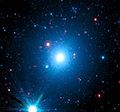Elliptical galaxy in the Fornax Cluster
NGC 1404 is an elliptical galaxy in the Southern constellation Eridanus . It was discovered on November 28, 1837, by the astronomer John Herschel .[ 5] tip of the red-giant branch distance indicator, it lies at a distance of approximately 60 million light-years from the Milky Way .[ 3] Fornax Cluster .[ 6] [ 7]
Characteristics
As usual with most elliptical galaxies, NGC 1404 is rich in globular clusters , with a population of them that has been estimated to be around 725;[ 8] NGC 1399 , the brightest galaxy of the Fornax Cluster.[ 9]
Studies using the X-ray telescope Chandra show how the ram-pressure stripping caused by the motion of NGC 1404 through Fornax' intracluster medium is stripping the galaxy of its hot gas,[ 10] [ 11]
Supernovae
Two supernovae have been observed in NGC 1404:
SN 2007on (type Ia , mag. 14.9) was discovered by the TAROT collaboration on 5 November 2007.[ 12] [ 13]
SN 2011iv (type Ia, mag. 12.8) was discovered by Stuart Parker on 2 December 2011.[ 14] [ 15]
Gallery
References
^ a b Skrutskie, Michael F.; Cutri, Roc M.; Stiening, Rae; Weinberg, Martin D.; Schneider, Stephen E.; Carpenter, John M.; Beichman, Charles A.; Capps, Richard W.; Chester, Thomas; Elias, Jonathan H.; Huchra, John P.; Liebert, James W.; Lonsdale, Carol J.; Monet, David G.; Price, Stephan; Seitzer, Patrick; Jarrett, Thomas H.; Kirkpatrick, J. Davy; Gizis, John E.; Howard, Elizabeth V.; Evans, Tracey E.; Fowler, John W.; Fullmer, Linda; Hurt, Robert L.; Light, Robert M.; Kopan, Eugene L.; Marsh, Kenneth A.; McCallon, Howard L.; Tam, Robert; Van Dyk, Schuyler D.; Wheelock, Sherry L. (1 February 2006). "The Two Micron All Sky Survey (2MASS)" . The Astronomical Journal . 131 (2): 1163– 1183. Bibcode :2006AJ....131.1163S . doi :10.1086/498708 ISSN 0004-6256 . S2CID 18913331 . ^ a b c "NGC 1404" . SIMBAD Centre de données astronomiques de Strasbourg . Retrieved 2021-02-21 .^ a b Hoyt, Taylor J.; Beaton, Rachael L.; Freedman, Wendy L.; Jang, In Sung; Lee, Myung Gyoon; Madore, Barry F.; Monson, Andrew J.; Neeley, Jillian R.; Rich, Jeffrey A.; Seibert, Mark (2021). "The Carnegie Chicago Hubble Program X: Tip of the Red Giant Branch Distances to NGC 5643 and NGC 1404" . The Astrophysical Journal . 915 (1): 34. arXiv :2101.12232 Bibcode :2021ApJ...915...34H . doi :10.3847/1538-4357/abfe5a S2CID 231728270 . ^ a b c d Gil de Paz, Armando; et al. (December 2007). "The GALEX Ultraviolet Atlas of Nearby Galaxies". The Astrophysical Journal Supplement Series . 173 (2): 185– 255. arXiv :astro-ph/0606440 Bibcode :2007ApJS..173..185G . doi :10.1086/516636 . S2CID 119085482 . ^ Seligman, Courtney. "New General Catalogue objects: NGC 1400 - 1449" . cseligman.com . Retrieved 2021-02-21 . ^ "Falling in Fornax" . www.eso.org . Retrieved 28 October 2019 .^ Blakeslee, J. P.; Jordan, A.; Mei, S.; Cote, P.; Ferrarese, L.; Infante, L.; Tonry, J. L. (March 2009). "The ACS Fornax Cluster Survey. V. Measurement and Recalibration of Surface Brightness Fluctuations and a Precise Value of the Fornax-Virgo Relative Distance" . The Astrophysical Journal . 694 (1): 556– 572. arXiv :0901.1138 Bibcode :2009ApJ...694..556B . doi :10.1088/0004-637X/694/1/556 . S2CID 16521293 . ^ Forbes, D. A.; Grillmair, C. J.; Williger, G. M.; Emerson, R. A. W.; Brodie, J. P. (January 1998). "HST imaging of the globular clusters in the Fornax cluster - NGC 1399 and NGC 1404" . Monthly Notices of the Royal Astronomical Society 293 (3): 325– 336. arXiv :astro-ph/9708025 Bibcode :1998MNRAS.293..325F . doi :10.1046/j.1365-8711.1998.01202.x S2CID 119362742 . ^ Bekki, K.; Forbes, D. A.; Beasley, M. A.; Couch, W. J. (October 2003). "Dynamical evolution of globular cluster systems in clusters of galaxies - I. The case of NGC 1404 in the Fornax cluster" . Monthly Notices of the Royal Astronomical Society . 334 (4): 1334– 1344. arXiv :astro-ph/0308202 Bibcode :2003MNRAS.344.1334B . doi :10.1046/j.1365-8711.2003.06925.x S2CID 16549156 . ^ Machaceck, M.; Dosaj., A.; Forman, W.; Jones, C.; Markevitch, M.; Vikhlinin, A.; Warmflash, A.; Kraft, R. (March 2005). "Infall of the Elliptical Galaxy NGC 1404 into the Fornax Cluster" . The Astrophysical Journal . 621 (2): 663– 672. arXiv :astro-ph/0408159 Bibcode :2005ApJ...621..663M . doi :10.1086/427548 . S2CID 14902493 . ^ http://chandra.harvard.edu/photo/2004/fornax/ Fornax Cluster:
Motions of Nearby Galaxy Cluster Reveal Presence of Hidden Superstructure^ Pollas, C.; Klotz, A. (2007). "Supernova 2007on in NGC 1404" . Central Bureau Electronic Telegrams . 1121 : 1. Bibcode :2007CBET.1121....1P . ^ "SN 2007on" . Transient Name Server . IAU . Retrieved 8 December 2024 .^ Noguchi, T.; Nakano, S.; Chen, J.; Wang, X. -F.; Yi, W. -M.; Zhang, J. -J.; Bai, J. M.; Zhang, T. -M.; Stritzinger, M.; Foley, R. J. (2011). "Supernova 2011iv in NGC 1404 = PSN J03385135-3535320" . Central Bureau Electronic Telegrams . 2940 : 1. Bibcode :2011CBET.2940....1N . ^ "SN 2011iv" . Transient Name Server . IAU . Retrieved 8 December 2024 .
External links
NGC 1404 at Wikimedia Commons

